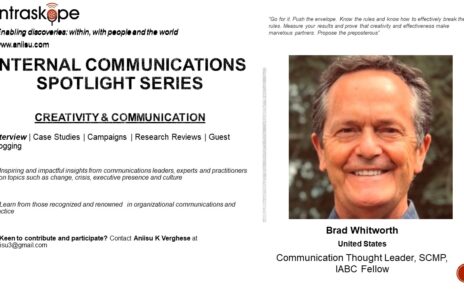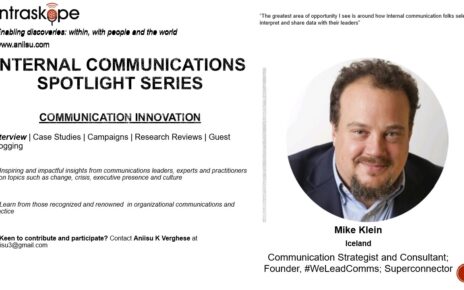How often do we pay attention to executing a great plan? What is the value of a fantastic plan when it remains on paper? what must communicators consider while executing to a plan? Learn this and more in this interview with Diana Bonczar, co-founder of Inko Group. Diana is a thought leader who focuses on internal communications and brings the community in Central Europe together. Diana is based on Brno,
Welcome to the 19th edition of Intraskope’s Spotlight Series featuring Diana Bonczar. I have been impressed by Diana’s ability to bring the best minds together to discuss contemporary topics related to internal communications in Central Europe. As a communications professional with managerial experience she shares knowledge and offering support through consulting services, training and mentoring. Her focus includes internal communications, company culture and employee engagement, linked closely to business strategy and brand, employer branding, diversity and inclusion as well as CSR. She is adept with communications strategy, planning and execution, and also with employees’ professional development through soft skills and leadership skills. Communication execution is her core area of expertise and I spoke to her about this topic.
Watch this interview with Diana to learn more.
About Intraskope’s Spotlight Series
In this series I interview key thought leaders on topics interrelated with internal communications such as culture, crisis, change, executive presence and leadership. The goal is to help unravel why they matter, what can leaders and communicators learn from experts and how we can put insights to practice. Watch these short interviews and get better at understanding these key topics and how you engage with internal communications.
Diana and I have spoken in the past on a couple of occasions, and I found her ability to distill ideas and approach internal communications creatively as an excellent skill. In this conversation we cover why executing well matters and what it takes to be ahead of stakeholder expectations.
“Get to know your stakeholders, building relations, knowing them as people, how they like to work, what’s their communication style, what interests them – it will all help you to work with them effectively when the time comes”, says Diana.
1. Why is Communication Execution important and when do you know you are ready to execute?
Communication execution is the essence of the communication process. It’s where all work around planning and preparation materializes and where the message takes final shape and goes out to the world.
In an ideal world, you follow your plan, gather input, shape your message, and you have enough time before the planned publication date to test your message with a couple of people to gather feedback. If you see it works and achieves planned goals, then you’re ready.
However, we don’t live in an ideal world, and I’m not sure if I know any communication professional who has the comfort to execute everything smoothly in line with the plan. In reality, many of us experience changing expectations of our stakeholders, missing input and moving deadlines. We’re often pushed to improvise and we decide we’re ready to execute after we assess if there’s any realistic chance to make a given communication any better.
2. How is it defined and how much time do you think communicators must pay attention when they plan communications?
In my opinion, communication execution is everything in between having a comms plan ready and getting feedback from sent out communication. I include the feedback loop here, not just pressing the “send” button as communication is a two-way street and once you launch it, it finishes when you know what the result was.
When you plan communication, you for sure have to do it with the execution in mind. It’s nice and inspiring to have an open mind, be creative and work thinking that only the sky is the limit, but if it’s supposed to be executed, you have to be realistic. You have to take into account the resources you have at your disposal, and – what might often be even more important – how smooth the cooperation with other stakeholders is, what their approach to communication is, and how supportive they are.
You also have to be ready to adjust your plan as the context might be changing. Be flexible, allow for a couple of open doors to introduce variations. Treat your plan as a direction, guidance for gathering input and orchestrating various comms elements, not as a step-by-step-instruction.
3. What aspects go into communication execution?
For me, execution is everything in between the plan and getting feedback. This includes gathering detailed input, working with it to shape the message for all chosen channels, producing the content for those channels (text, graphics, everything that’s needed), helping speakers prepare (if you have them in your plan), testing your message, getting all needed approvals, publishing, and gathering feedback. And by feedback I don’t mean the whole detailed measurement and stats, but checking the reception, if the message landed well, was clear and started having the expected effect.
What I also want to underline is that there’s no clear, no sharp end of planning and start of execution. You might have a plan ready, waiting for the green light to make it happen, but then you have to be constantly ready to adjust it. For instance, you might find out that there’s no chance to get some detailed information (imagine a change in the organization and something that hasn’t been decided yet), so you have to adjust what is being communicated and when. Or there’s some unplanned happening in the organization which has to go out urgently with enough spotlight. You will constantly come back to your plan, adjust, come back to execution, then again to the plan, and so on.
4. How can communicators avoid mistakes while executing their plans?
Practice, experience and lessons learned. One of the unpleasant things that may happen to you is if you repeat your own mistakes again and again.
Another thing is getting to know your stakeholders, building relations, knowing them as people, how they like to work, what’s their communication style, what interests them – it will all help you to work with them effectively when the time comes. And those might be both your internal clients for whom you prepare the communication as well as peers such as graphic designers, IT or Facilities teams.
Mistakes often happen because we underestimate the needed effort, the workload and the time required for it. We think we can do something quicker, but then we find out that’s not true, that there are some details we can’t do alone, or there’s something to do that we missed in our plan.
We also tend to believe that if the message is urgent, then everyone should focus just on it, but even for our client this priority message might be far down on their priority list, below some other even more strategic tasks. We get frustrated, ten we work in a hurry and that’s never good.
Another problem is sticking to the plan that doesn’t take into account everything that changed on the way.
5. What advice do you have for communicators when it comes to executing messages?
Be patient, don’t take it personally, don’t get frustrated. That’s on the mental side.
When it comes to practice, get to know the people – your stakeholders and peers, and their personal preferences and style. And also get to know their processes and tools so that you’re aware how they work and how to best cooperate with them to ease their part of the work.
Then get to know your tools so that you’re able to handle them smoothly. And have backup in case you need support.
And – this is probably the most helpful in the whole process – build relationships with your stakeholders. Make sure they remember what you need from them to be able to support them. Make them include you in their topics soon enough so that you have the right amount of time and information to build a plan that makes sense and execute smoothly with the support and engagement of all needed parties.
Watch the complete video interview on YouTube or read the complete transcript above.
Missed the earlier episodes? Watch them here: D. Mark Schumann (Culture), Peter Yorke (Executive Presence), Sia Papageorgiou (Leadership Communications), Dianne Chase (Strategic Storytelling), Gloria Walker (Communication Planning), Rebecca Sangster-Kelly (Stakeholder Management), Ray Walsh (Localizing Employee Communications), Prof. Matt Tidwell (Reputation), Geri Rhoades (Manager Communications), Erik K Meyers (Business Acumen), Russell-Olivia Brooklands (IC Practice Governance), Paul Barton (Public Speaking and Business Communication), Cyrus Mavalwala (Digital Communication), Elvera N Makki (Social Impact Communication), Philippe Borremans (Communication Preparedness) and Magdalena Petryniak (Influence in Communications), Priya Bates (Communicating Diversity & Inclusion) and Zora Artis (Communication Alignment).
You can also look up the ongoing Intraskope’s Spotlight on Internal Communication Series featuring practitioners from around the globe sharing best practices and perspectives.
Liked the interview? Post your comments and share it with your network.
Keen to participate in the ongoing series on Personal Branding, Crisis Communications, Internal Communications or CSR Communications? Drop me a note at [email protected]
Here are Internal Communications resources you can use:
- Learn: Internal Communications Fundamentals Course on Thinkific
- Internal Communications Series: https://forms.gle/KcqmPzLwq7NQi5Km6
- Chat with Aniisu – Internal Communications: https://www.instamojo.com/intraskope/connect-with-aniisu-60-minute-personalized-d/?ref=store
- Internal Communications workshops: https://bit.ly/2zdBRl1
You can also visit my website www.intraskope.com and You Tube channel to know more about my work.
#IC #execution #patience #commsfocus #resilience #clarity #strategy #experience #practices #success #agility #adapability #involvement #passion #internalcomms #communications #internalcommunications # #covid19 #DianaBonczar


